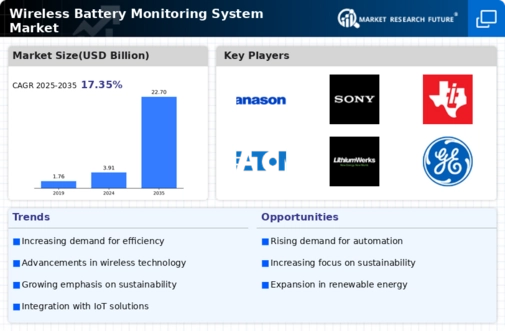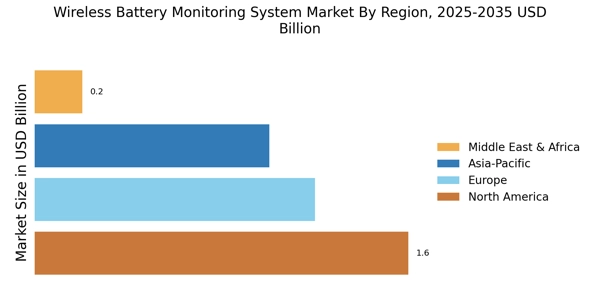Increased Focus on Energy Efficiency
The heightened focus on energy efficiency across various sectors is propelling the Wireless Battery Monitoring System Market. Organizations are increasingly recognizing the importance of optimizing energy consumption to reduce costs and environmental impact. Wireless battery monitoring systems provide critical insights into battery performance, enabling users to make informed decisions regarding energy usage and maintenance. Data suggests that energy efficiency initiatives can lead to cost savings of up to 30% in some industries. As businesses strive to meet regulatory requirements and sustainability goals, the demand for advanced monitoring solutions is likely to rise. This trend indicates a robust growth trajectory for the Wireless Battery Monitoring System Market, as companies seek to implement technologies that enhance energy efficiency and reduce operational costs.
Growing Adoption of Electric Vehicles
The surge in electric vehicle (EV) adoption is a key driver for the Wireless Battery Monitoring System Market. As the automotive sector transitions towards electrification, the need for efficient battery management systems becomes critical. Wireless battery monitoring systems enable manufacturers to track battery health, performance, and charging cycles, which are essential for ensuring vehicle safety and efficiency. Recent statistics indicate that the EV market is expected to grow at a compound annual growth rate of over 20% in the next decade. This rapid expansion is likely to create a substantial demand for wireless battery monitoring solutions, as automakers strive to enhance battery performance and extend vehicle range. Consequently, the Wireless Battery Monitoring System Market is poised for significant growth as the automotive landscape evolves.
Rising Demand for Renewable Energy Solutions
The increasing emphasis on renewable energy sources is driving the Wireless Battery Monitoring System Market. As more organizations and governments invest in solar, wind, and other renewable technologies, the need for efficient energy storage solutions becomes paramount. Wireless battery monitoring systems facilitate real-time tracking of battery performance, ensuring optimal energy storage and usage. According to recent data, the renewable energy sector is projected to grow at a compound annual growth rate of over 8% in the coming years. This growth directly correlates with the demand for advanced battery management systems, as they play a crucial role in maximizing the efficiency and lifespan of energy storage systems. Consequently, the Wireless Battery Monitoring System Market is likely to experience substantial growth as the shift towards renewable energy accelerates.
Technological Advancements in Battery Technologies
Technological innovations in battery technologies are significantly influencing the Wireless Battery Monitoring System Market. The development of advanced battery chemistries, such as lithium-sulfur and solid-state batteries, necessitates sophisticated monitoring systems to ensure safety and performance. These innovations are expected to enhance energy density and reduce charging times, which in turn increases the complexity of battery management. As a result, the demand for wireless monitoring solutions that can provide real-time data and predictive analytics is likely to rise. Market data indicates that the battery technology sector is anticipated to grow at a rate of approximately 10% annually, further propelling the Wireless Battery Monitoring System Market. This trend suggests that manufacturers will increasingly seek advanced monitoring solutions to optimize battery performance and longevity.
Regulatory Support for Battery Management Solutions
Regulatory frameworks supporting battery management solutions are emerging as a significant driver for the Wireless Battery Monitoring System Market. Governments worldwide are implementing policies aimed at enhancing battery safety and performance, particularly in sectors such as transportation and renewable energy. These regulations often mandate the use of advanced monitoring systems to ensure compliance with safety standards. As a result, manufacturers are increasingly adopting wireless battery monitoring solutions to meet these regulatory requirements. Market analysis reveals that regions with stringent battery management regulations are likely to see accelerated growth in the Wireless Battery Monitoring System Market. This regulatory support not only fosters innovation but also encourages investment in advanced battery technologies, further driving market expansion.


















Leave a Comment